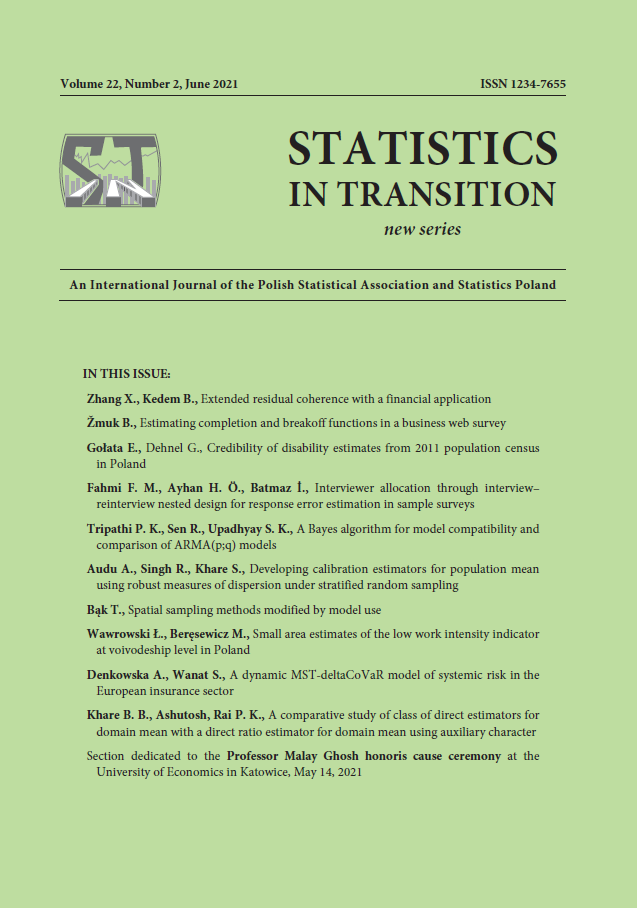ARTICLE
ABSTRACT
Residual coherence is a graphical tool for selecting potential second-order interaction terms as functions of a single time series and its lags. This paper extends the notion of residual coherence to account for interaction terms of multiple time series. Moreover, an alternative criterion, integrated spectrum, is proposed to facilitate this graphical selection. A financial market application shows that new insights can be gained regarding implied market volatility.
KEYWORDS
interaction, residual coherence, nonlinear, time series, volatility index
REFERENCES
Brillinger, D. R., (1965). An introduction to polyspectra. The Annals of mathematical statistics, pp. 1351–1374.
Brillinger, D. R., Rosenblatt, M., (1967). Asymptotic theory of estimates of kth-order spectra. Proceedings of the National Academy of Sciences of the United States of America, 57(2), p. 206.
Elgar, S., Vanhoff, B., Aguirrre, L. A., Freitas, U. S., Chandran, V., (1998). Higher-order spectra of nonlinear polynomial models for chua’s circuit. International Journal of Bifurcation and Chaos, 8(12), pp. 2425–2431.
Euan, C., Sun, Y., Ombao, H., (2019). Coherence-based time series clustering for statistical inference and visualization of brain connectivity. Annals of Applied Statistics, 13(2), pp. 990–1015.
Hinich, M. J., (1979). Estimating the lag structure of a nonlinear time series model. Journal of the American Statistical Association, 74 (366a), pp. 449–452.
Kedem, B., (2016). Coherence consideration in binary time series analysis. Handbook of Discrete-Valued Time Series, p. 311.
Kedem, B., Fokianos, K., (2002). Regression models for time series analysis. Wiley, Hoboken.
Kedem-Kimelfeld, B., (1975). Estimating the lags of lag processes. Journal of the American Statistical Association, 70(351a), pp. 603–605.
Khan, D., Katzoff, M., Kedem, B., (2014). Coherence structure and its application in mortality forecasting. Journal of Statistical Theory and Practice, 8(4), pp. 578–590.
Kimelfeld, B., (1974). Estimating the kernels of nonlinear orthogonal polynomial functionals. The Annals of Statistics, pp. 353–358.
Koopmans, L. H., (1974). The spectral analysis of time series. New Yorkn NY: Academic Press.
Maharaj, E. A., D’Urso, P., (2010). A coherence-based approach for the pattern recognition of time series. Physica A: Statistical mechanics and its Applications, 389(17), pp. 3516–3537.
Nikias, C. L., Mendel, J. M., (1993). Signal processing with higher-order spectra. IEEE Signal processing magazine, 10(3), pp. 10–37.
Sanaullah, M., (2013). A review of higher order statistics and spectra in communication systems. Global Journal of Science Frontier Research, Physics and Space Science, 13(4).
Sun, F. T., Miller, L. M., D’Esposito, M., (2004). Measuring interregional functional connectivity using coherence and partial coherence analyses of fmri data. Neuroimage, 21(2), pp. 647–658.
Tick, L. J., (1961). The estimation of “transfer functions” of quadratic systems. Technometrics, 3(4), pp. 563–567.
Whaley, R. E., (1993). Derivatives on market volatility: Hedging tools long overdue. The journal of Derivatives, 1(1), pp. 71–84.
Wiener, N., (1958). Nonlinear problems in random theory. M.I.T. Press, Cambridge.
